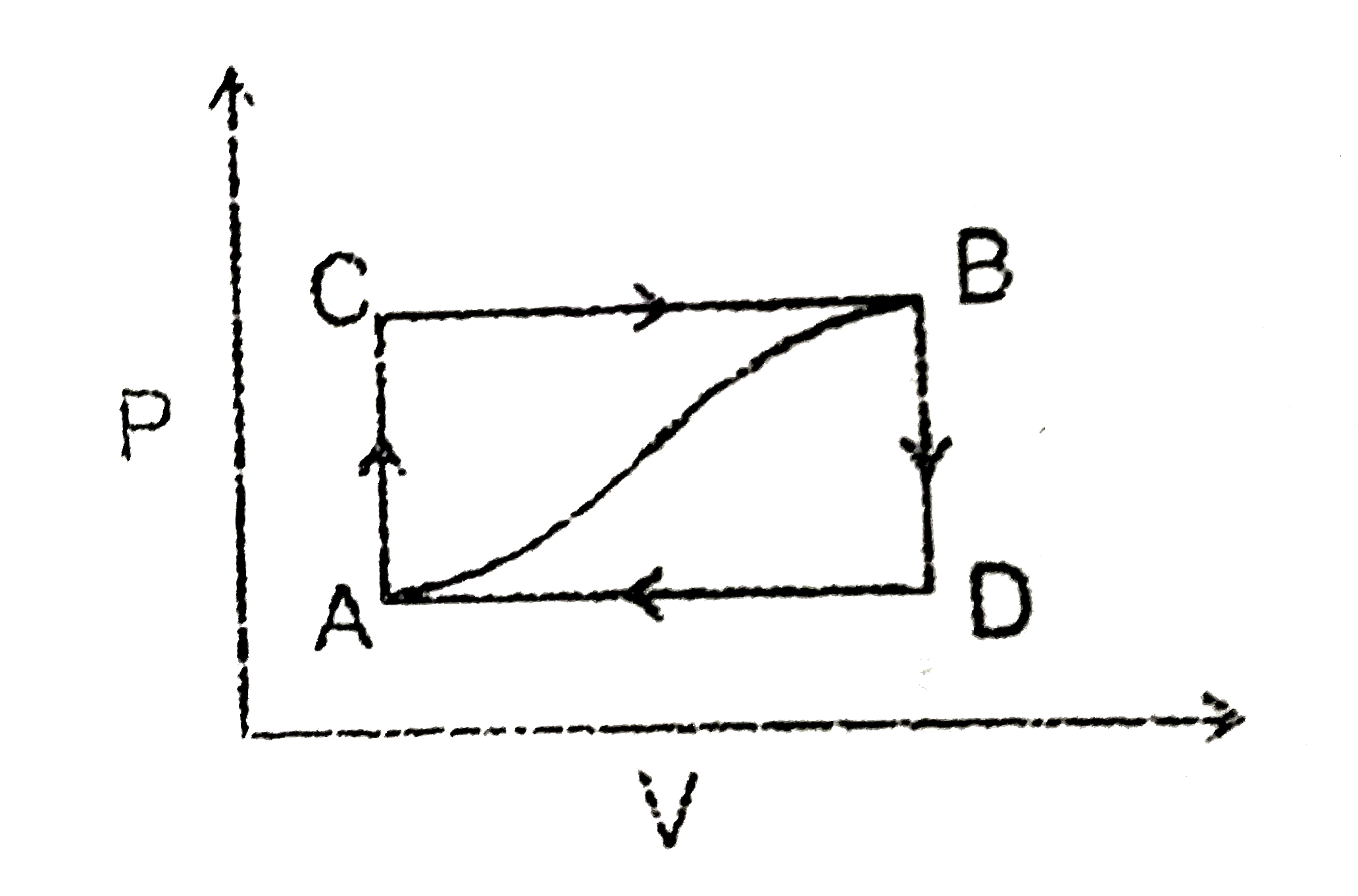When a thermodynamic system is taken firom an initial state I to a final state F along the path lAF, as shown in figure-3.8, the heat energy absorbed by the system is Q = 55 J and the work done by the system is 25 J. If the same system is taken along the path IBF, the value of Q= 35 J.

If UI=10 J, what is UF ?
The first law of thermodynamics states that
ΔQ=ΔU+ΔW or Q=(UF−UI)+W
Here UI and UF are the internal energies in the initial and the final state. Given that, for path lAF, Q = 55 J and W= 25 J. Therefore,
ΔU=UF−UI=Q−W=55−25=30J
The internal energy is independent ofthe path, it depends only on the initial and final states of the system'. Thus the internal energy between I and F states is 30 J irrespective of the path followed by the system.
Given UI=10 J. Therefore , UF=ΔU+UI=30+10=40 J
Topper's Solved these Questions
- THERMODYNAMICS LAWS & SPECIFIC HEATS OF GASES BOOK - PHYSICS GALAXY - ASHISH ARORACHAPTER - THERMODYNAMICS LAWS & SPECIFIC HEATS OF GASES EXERCISE - Discussion Question
17 Videos
- THERMODYNAMICS LAWS & SPECIFIC HEATS OF GASES BOOK - PHYSICS GALAXY - ASHISH ARORACHAPTER - THERMODYNAMICS LAWS & SPECIFIC HEATS OF GASES EXERCISE - Conceptual MCQs Single Option Correct
21 Videos
- PHOTOELECTRIC EFFECT AND MATTER WAVESBOOK - PHYSICS GALAXY - ASHISH ARORACHAPTER - PHOTOELECTRIC EFFECT AND MATTER WAVESEXERCISE - Unsolved numerical problems
42 Videos
- WAVE OPTICSBOOK - PHYSICS GALAXY - ASHISH ARORACHAPTER - WAVE OPTICSEXERCISE - Unsolved Numerical Problems
28 Videos
Similar Questions
When a thermodynamic system is taken from an initial state I to a final state F along the path IAF, as shown in Fig. the heat energy absorbed by the system is Q=55J and work done by the system is W=25J. If the same system is taken along the path IBF, the value of Q=35J.
(a) If W=−15J for the curved path FI, how much heat energy is lost by the system along this path ?
(b) If U1=10J, what is UF ?
(d) If UB=20J, what is Q for the process BF and IB ?
View SolutionWhen a thermodynamic system is taken from an initial state I to a final state F along the path IAF, as shown in Fig. the heat energy absorbed by the system is Q=55J and work done by the system is W=25J. If the same system is taken along the path IBF, the value of Q=35J.
(a) If W=−15J for the curved path FI, how much heat energy is lost by the system along this path ?
(b) If U1=10J, what is UF ?
(d) If UB=20J, what is Q for the process BF and IB ?
View Solution
Knowledge Check
When a system is taken from stata a to state b along the path acb as shown in figure, 60 J of heat flows into the system and 30 J of work is done by the system. Along the path adb, if the work done by the system is 10 J, heat flow into the system is
 A100 JB20 JC80 JD40 J
A100 JB20 JC80 JD40 JFor a gaseous state if heat supplied to the system is 100 J and work done by the system is 25 J. then internal energy of the system is
A125 JB100 JC50 JD75 JIf the amount of heat given to a system is 35 J and the amount of work done on the system is 15 J, then the change in internal energy of the system is
A−50JB20JC−20JD50 J
For a gaseous state if heat supplied to the system is 100 J and work done by the system is 25 J. then internal energy of the system is
View Solutiona thermodynamic system is taken from the state i to statef along the path iaf. It is found that the heat absorbed by the system is 40 cal and work done by the system is 16.19 cal. Along the path i bf, the heat absorbed is 35 cal.
(a) Find the work done along the path i bf.
(b) If W = - 10 cal for the curved return path fi, what is for this path ?
(c) Take Ub=20cal, what is Uf?
(d) If Ub=20 cal, what is for the process ib?

View SolutionWhen a system is taken from state A to state B along path ACB as shown in figure below, 80J of heat flows into the system and the system does 30J of work.

How much heat flows into the system along path ADB if the work done by the system is 10J:
View SolutionIn a process, 701J of heat is absorbed by a system and 394J of work is done by the system. What is the change in internal energy for the process?
View SolutionWhen a system is taken from state A to state B along path ACB as shown in figure below, 80J of heat flows into the system and the system does 30J of work.

How much heat flows into the system along path ADB if the work done by the system is 10J:
View Solution
